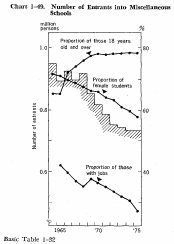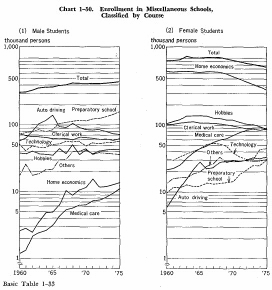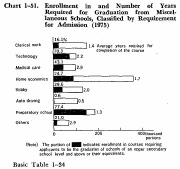| Home > Policy > White Paper, Notice, Announcement > White Paper > EDUCATIONAL STANDARDS IN JAPAN 1975 > CHAPTER1 7 | ||
Miscellaneous schools have been playing a role of meeting manifold educational demands as an educational institution providing an opportunity for vocational and technical education outside school education, in response to the educational and social demand for capable personnel. Their educational contents range over wide areas of clerical work, technology, medical care, home economy, etc., and their educational standards and schooling are also varied.
The number of entrants into miscellaneous schools totaled 730,000 persons in 1975, of whom female students accounted for 57.8% at 420,000 and those 18 years old and above for 78.2% at 570,000. The number of entrants into miscellaneous schools has been taking a downward turn since around 1969, but the proportion of entrants of 18 years old and above has rather been on a gradual increase, signifying that miscellaneous schools are playing role as an institution of so-called "post-secondary education." Whi1e the proportion of female students has been diminishing yearly, this trend is thought to correspond to the recent increase in the rate of female students advancement to upper secondary schools, junior colleges and universities. The rate of miscellaneous school students having jobs has also been declining yearly.

As regards the number of male students in 1975, classified by type of courses, preparatory school students were the most numerous at 160,000 persons, accounting for 34.7% of the total, followed by those learning auto driving, clerical work, various techniques and hobbies in that order. Of female students, the proportion of those specializing in home economics ranks the highest at 46%, followed by those majoring in clerical work, medical care, hobbies, etc. As for transition in enrollment, the number of both male and female students keeps increasing in preparatory schools and in medical courses, while the number of female students majoring in home economics is on the decline.


The proportion of students enrolled in the "courses requiring applicants to be the graduates of schools of an upper secondary school level and above or the equivalent" accounts for 35.4% of the total number of students. Of such courses, the proportion of those in technical skills and medical care is especially high.
Meanwhile, with regard to miscellaneous schools, the new special training school system was instituted in 1976. Under this system, while the current miscellaneous school system is left at it is, a number of those schools with specified educational standards and scale are certified as special training schools as a means of encouraging their educational functions. The expansion and development of this system in the future is anticipated.
| Back to Top | MEXT HOME |